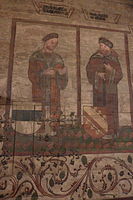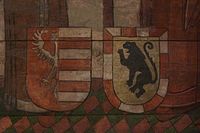Wall and ceiling paintings in the town hall of Mühlhausen (Thuringia)
The wall and ceiling paintings in the representative rooms of the town hall of Mühlhausen in the Unstrut-Hainich district in Thuringia go back to the 15th century. The large council chamber has a plank wall with a late Gothic figure cycle ( quaternions of the imperial constitution ) and paneling with paintings from the Renaissance . Fragments of the Gothic painting and late Baroque depictions have been preserved on the wooden barrel vault of the town hall hall .
Wall and ceiling paintings in the large council chamber
Late Gothic wall paintings in the Great Council Chamber
During the renovation of the town hall in 1913, paintings from the second half of the 15th century were discovered on the east side of the council chamber under a wall covering on planks. Six life-size princes are depicted on six fields, about one meter wide and framed by painted frames, each facing each other in pairs. All persons are equal, which is to emphasize their equality. They are marked by tapes above their heads. From left to right are shown: the Landgrave von Leuchtenberg , the Landgrave in Alsace , the Burgrave of Magdeburg , the Burgrave of Nuremberg , the Burgrave of Rheineck and the Burgrave of Strasbourg . The figures are dressed in princely, some fur-trimmed robes and wearing their regalia belonging berets . Her coats of arms are depicted at her feet . The prince cycle preserved was probably part of a more extensive program and was intended to represent the estates of the empire as participants in the council meetings. City bills from 1459/60 come down to a painter by the name of Tielemann who carried out work in the council chamber. However, it is assumed that the existing paintings are later overpaintings, which due to the clothing shown are dated to the late 15th century. The cityscape with the inscription Hagenau above the passage to the town hall hall, which came to light after the door crown was removed , also dates from the Gothic period .
Renaissance wall paintings in the Great Council Chamber
With the exception of the exposed plank wall on the east side, the walls of the large council chamber are covered with wood paneling, which, as the contract from 1571 shows, was carried out by the carpenter Georg Hecht from Mühlhausen. The paintings are by Bernhard Stephan. The representations on the north and south walls are dedicated to the virtues. On the north wall, FORTIDVDO , bravery, is embodied by a female figure with two columns. Hercules , depicted with a snake, is also a symbol of bravery and strength . According to the legend, he is said to have strangled a snake while he was still in his cradle. In addition, a female figure with anchor SPES embodies hope. On the south wall the virtues JVSTITIA , justice (with sword and scales), TEMPERANTIA , moderation (with a bowl and a filled jug) and CARITAS , love (as a mother with twins) are depicted. Above the door to the town hall and the exposed Gothic view of the city, the painter has inserted a cartouche with his name Bernhart Stephan into the scene with Adam and Eve.
The painting of the west wall with the representation of the representatives of the Holy Roman Empire ties in with the Gothic paintings. These should be renewed in a contemporary form , presumably after the regaining of imperial immediacy granted by Emperor Charles V. Emperor Maximilian II is enthroned in the center , on his right the archbishops of Mainz , Trier and Cologne , on his left the electors of Bohemia, Saxony , the Electoral Palatinate and Brandenburg . Above the representations of the people there are inscriptions that identify the people depicted. The inscription on the King of Bohemia was probably later in Chur Bayern changed since the Elector of Bavaria dignity only in 1648 after the Peace of Westphalia gained. A frieze with the coats of arms of the electors runs under the portrayals of people. These include the coats of arms of the four margraves (Meißen, Baden, Moravia, Brandenburg), the four burgraves (Magdeburg, Nuremberg, Rheineck, Stromberg), the four landgraves (Thuringia, Hesse, Leuchtenberg, Alsace), the four counts (Savoy, Cilly / Steiermark, Kleve, Schwarzburg), the four noble boys (Tufis, Westerburg, Aldewalde, Barons of Limburg), the four knights (Andlau, Mellingen, Strundeck, Frauenberg), the four cities (Augsburg, Metz, Aachen, Lübeck), the four villages (Bamberg, Schlettstadt, Ulm, Hagenau), the four farmers (Cologne, Regensburg, Konstanz, Salzburg). The division into ten groups of four, which symbolize the individual classes of the empire, corresponds to the theory of quaternions , an idea of the hierarchical order of the Holy Roman Empire developed in the early 15th century, which is derived from the Golden Bull .
Ceiling painting of the town hall hall
Gothic fragments
The extension of the town hall hall, which was built around 1330, is covered with an ogival wooden barrel, some of which have been painted from the time it was built. The barrel is divided by belt-arched ornamental friezes with medallions on which animal fables were originally depicted. Six hunting scenes with Gothic fragments are preserved on the north side. They depict a hunter blowing a hunting horn, a bear put by dogs, a wolf put by dogs, and a deer put by dogs. The scenes from the fable Reinecke Fuchs on the south wall were renewed during the renovation of the town hall in 1912/13, as can be read in the inscription on a medallion.
Baroque ceiling painting
The baroque, round-arched plank barrel, which was withdrawn in 1747, adjoins the Gothic pointed barrel to the east. The rulers of the four world empires are depicted in large painted cartouches according to the vision of the prophet Daniel . The paintings are attributed to Johann Hermann Bauer from Mühlhausen. One scene is dedicated to Nimrod , the founder of the Babylonian Empire, who built the Tower of Babel . The next scene is about Cyrus , the Persian king, who conquered the Babylonian Empire and freed the Jews from Babylonian captivity . The other two depictions have Alexander the Great and Julius Caesar as their theme.
literature
- Gerhard Seib: The representative rooms of the Mühlhausen town hall . In: The town hall of Mühlhausen in Thuringia. Contributions to the history of architecture and art . Special edition 13. Ed. Mühlhausen Museums in cooperation with the Mühlhausen Historical and Preservation Society. V., Mühlhausen 2000, ISBN 3-935547-01-3 , pp. 130-163.
Web links
Coordinates: 51 ° 12 ′ 32 ″ N , 10 ° 27 ′ 22 ″ E







